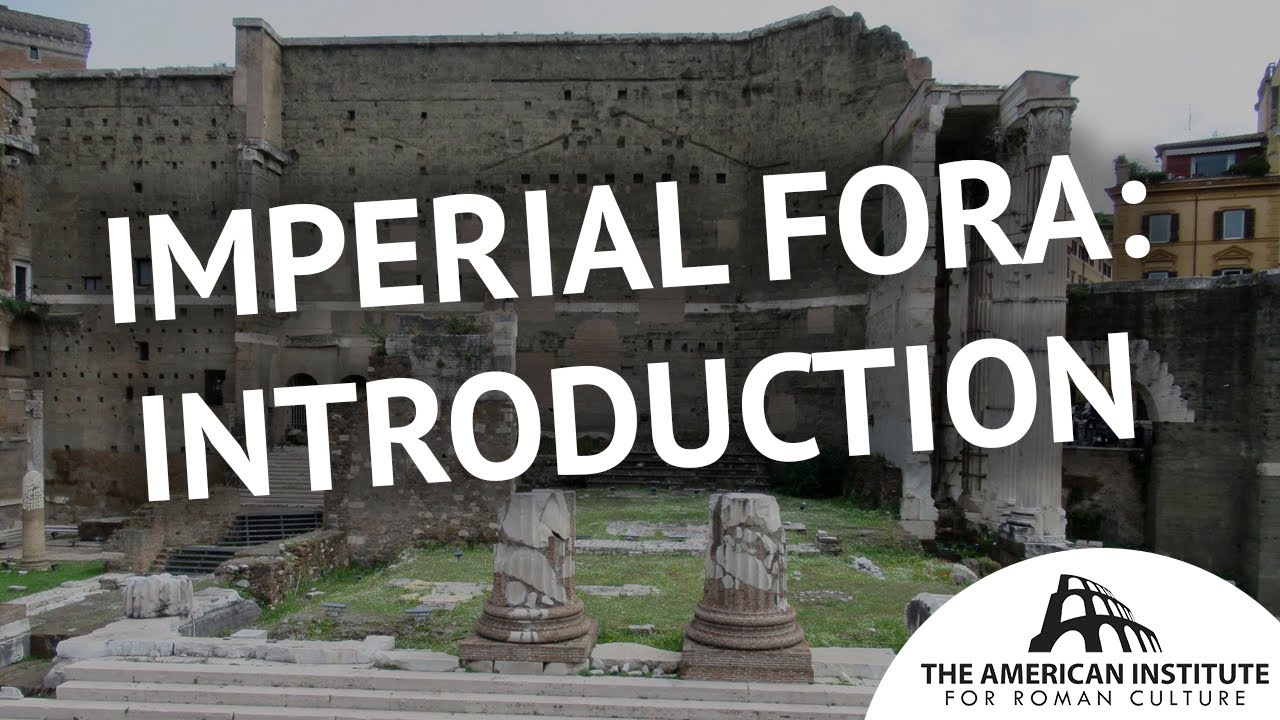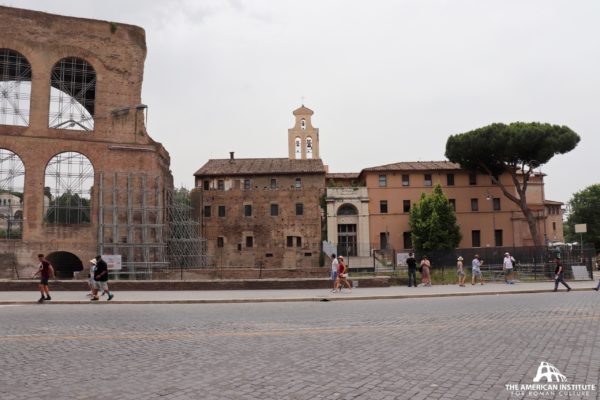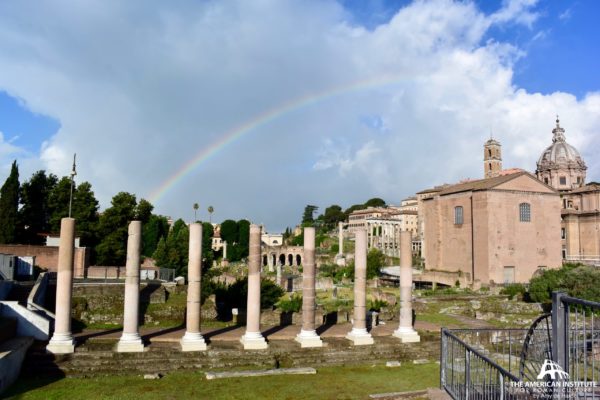After celebrating his triumph in AD 71, Vespasian built his forum in AD 75 (Dio,History 65.15) with the spoils from his victory in Judea. His complex is a little atypical for the way in which the Temple of Peace was set back into the portico that surrounded the piazza. It was famed for its massive amounts of gold and other precious materials taken from the Temple in Jerusalem (Josephus, The Jewish War, 7.158). The forum included among its treasures the Menorah, depicted on the Arch of Titus on the Velia Hill.
Entirely destroyed in the fire of Commodus AD 192, the forum you see today is a Severan-era rebuild. Impressive remains were revealed in recent excavations and conservation work. Only a small portion is revealed, but the original space was 110 X 105 m, ten times the area occupied by the Augustan Ara Pacis in the Campus Martius. The central piazza was filled with small stalls or offices for business activity (later ripped up and filled in with soil for agricultural pursuits, as discovered in recent excavations.
Excavations also revealed an intact granite column toppled over (scale of the temple was 60 foot shafts), a large portion of marble and granite pavement, and industrial-level activity for centuries (6C- 10C) of the lime-kiln burners who smashed and burned marble, reducing the stone into lime for building material. The impressive wall of a hall in the porticoed area toward the Forum Romanum contained the Forma Urbis marble map, composed of 150 slabs of marble for an area of more than 50 X 50 feet, descorated with hundreds of labeled monuments and houses and streets and fountains, at a scale of 1; 240- surprisingly accurate and extremely helpful resource for the study of the topography of ancient Rome. Fragments were first found in 1562 at the base of the wall and some pieces incorporated into medieval walls. A number of fragments were found recently, in 2006. Each puzzle piece constitutes a clue of what 3C Rome looked like. The map was probably a showpiece, a marble version of what was a legal document, periodically emended on paper or velum. Behind this Forma Urbis wall was the contiguous construction of the Church of SS. Cosma and Damiano (6C), also dependent on the forum construction.
To get a sense of the original extent of the forum, which was massive, you need to take into account the new excavations, previously described, the recently re-erected granite columns (anastylosis) behind the Basilica Aemilia, the firewall of the Forum Transitorium (where the Colonnacce stand), and the Tor dei Conti 13C medieval tower (originally 50 m high), at the start of the modern Via Cavour street.
Explore further:
PAX, TEMPLUM, (aedes, Vict.; Εἰρήνης νεώς, Procop.; Εἰρηναῖον, Cass. Dio lxxii.; τέμενος Εἰρήνης , other Greek writers): the temple of Peace which was begun by Vespasian after the capture of Jerusalem in 71 A.D., and dedicated in 75 (Suet. Vesp. 9; Joseph. b. Iud. vii. 5. 7 (158) ; Cass. Dio lxv. 15. ; Aur. Vict. Caes. 9. 7; Ep. 9. 8). It stood in the middle of the forum Pacis, north of the basilica Aemilia (Mart. i. 2. 8), probably at the junction of the modern Vie Alessandrina and dei Pozzi. Statius seems to ascribe the completion of this temple to Domitian (Silv. iv. 3. 17; cf. iv. I. 13), but this emperor’s claim may have had little foundation (cf. Suet. Dom. 5). Within the temple, or attached closely to it, was a library, bibliotheca Pacis (Gell. v. 21. 9; xvi. 8. 2; Boyd, 16-17, 36-37). In it were placed many of the treasures brought by Vespasian from Jerusalem, as well as famous works of Greek artists (Joseph. b. Iud. vii. 5. 7; Plin. NH xii. 94; xxxiv. 84; xxxv. 102, 109; xxxvi. 27, 58; Paus. vi. 9. 3; Iuv. ix. 23; Hephaest. ap. Phot. Bibl. 149. 32 Bekk.), and Pliny (NH xxxvi. 102) speaks of it, the basilica Aemilia and the forum of Augustus, as the three most beautiful monuments in Rome.
Just before the death of Commodus, probably in 191, the temple was destroyed by fire (Cass. Dio lxxii. 24. I; Galen, de comp. med. i. I), 1 but it must have been restored, probably by Severus, for it is mentioned in the succeeding centuries as one of the most magnificent buildings in the city (Herod. i. 14. 2; Amm. Marcell. xvi. 10. 14; Hist. Aug. trig. tyr. 31. 10). It gave its name to the fourth region of the city (Not. Reg. IV). In 408 there were seismic disturbances for seven successive days in the forum Pacis (Marcell. Comes, Chron. min. ed. Mommsen ii. 69: in foro Pacis per dies septem terra mugitum dedit), and the temple may have been injured then. At any rate Procopius (BG iv. 21), writing in the sixth century, says that it had long since been destroyed by lightning, although there were still many works of art set up in the immediate vicinity.
The enclosure within which the temple stood is not called forum in literature until after the time of Constantine. Enclosure and temple together appear in Pliny (xxxvi. 27) as Pacis opera, and in the Greek writers ascτέμενος Εἰρήνης (see above). Forum Pacis is found in Ammianus, Polemius Silvius and Marcellinus Comes (locc. citt.), φόρον Εἰρήνης in Procopius (loc. cit.); forum Vespasiani first in Ep. de Eulalio antipapa a. 418 (ap. Migne xviii. 397), Polemius Silvius (loc. cit.), and undoubtedly in Aurelius Victor (Caes. 9. 7). On the north-west it adjoined the (later) forum Transitorium, and on the south-east the basilica of Constantine, being rectangular in shape with the same orientation as the other imperial fora. Its length was 145 metres, and its width about two-thirds as much, although its north-east boundary is uncertain. It had an enclosing wall of peperino lined with marble and pierced with several gates. The peperino blocks have left impressions on the concrete of the basilica of Constantine, the north-west side of which was set against it. At the south-east corner there was an entrance from the Sacra via through a monumental passage which, after several changes, is now the church of SS. Cosma e Damiano. (For the history and description of this building, and the theory that it was the Urbis fanum, mentioned by Aurelius Victor (40. 26) as built by Maxentius and consecrated to Constantine, and not the templum divi Romuli, see P. Whitehead, BCr 1913, 143-165; YW 1913, 21.) Further investigations have led him to the conclusion that the rectangular building in opus quadratum 2was the temple of the Penates as restored by Augustus (AJA 1923, 414; 1927, 1-18; RPAiii.83-95). In the time of Severus a wall was built across the north-east end of this entrance,3 and on its north-east side, towards the forum, on a facing of marble slabs, was placed the so-called Capitoline Plan of the city, Forma Urbis Romae, the fragments of which were first discovered in May and June 1562. A facsimile is fixed to the wall of the garden of the Palazzo dei Conservatori. (For the description and discussion of this Plan, see Jord. Forma Urbis Romae regionum XIV, Berlin 1874; H. Elter, de Forma Urbis Romae, diss. i. ii., Bonn 1891; Hulsen, Piante icnografiche, Mitt. 1890, 46-63; Ann. d. Inst. 1867, 408– 423; 1883, 5-22; BC 1886, 270-274; 1893, 128-134; 1901, 3-7; Mitt. 1889, 79, 229; 1892, 267; RhM 1894, 420; HF i. p. 534; and for the discovery of new fragments, and the rearrangement on the wall of the museum, NS 1882, 233-238; 1884, 423 ; 1888, 391-392, 437, 569; 1900, 633-634; BC 1888, 386; 1899, 3-21; 1902, 347-348; 1903, 380; Mitt. 1916, 152; CR 1899, 234; 1901, 330; 1902, 96; Atti del Congresso internazionale di Scienze storiche (1903), Rome 1907, i. 111-122; Lanciani,. Golden Days of the Renaissance in Rome, Boston 1906, 130; PI. 2-5; CRA 1910, 499-508; DAP 2. xi. 101-107; DR 209-213; RE Suppl. iv. 484-485.) Maxentius in any case added the round building, with its facade on the Sacra via (RA 215-217).
The history of the forum Pacis is that of the templum, and apart from the entrance just described, scarcely any traces of either have been found except a portion of the pavement of giallo antico and pavonazzetto of the southern angle of the form ten metres below the present level of the Via del Tempio della Pace (BC 1876, 52-53 ; see in general HJ 2-7; Rosch. iii. 1721; Gilb. iii. 135, 186-187 ; Thedenat 190-193).
This content is brought to you by The American Institute for Roman Culture, a 501(C)3 US Non-Profit Organization.
Please support our mission to aid learning and understanding of ancient Rome through free-to-access content by donating today.
Cite This Page
Cite this page as: Darius Arya, The American Institute for Roman Culture, “Forum Vespasian & Templum Pacis (Forum of Vespasian & Temple of Peace)” Ancient Rome Live. Last modified 10/24/2019. https://ancientromelive.org/forum-vespasian-templum-pacis-forum-of-vespasian-temple-of-peace/
License
Created by The American Institute of Roman Culture, published on 10/24/2019 under the following license: Creative Commons: Attribution-NonCommercial-ShareAlike. This license lets others remix, tweak, and build upon this content non-commercially, as long as they credit the author and license their new creations under the identical terms. Please note that content linked from this page may have different licensing terms.








